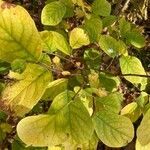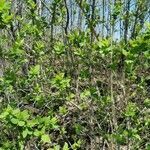Shrub 1–2 m; lvs broadly oblong-obovate or obovate to ovate, 5–8 cm, on petioles 2–5 mm; fls 7–10 mm, the stamens protruding 3 mm; fr ellipsoid, 12–15 mm, pale yellowish-green, quickly deciduous. Rich, moist woods; N.S. and s. Que. to Minn., s. to Fla., Ala., Ark., and Okla.




